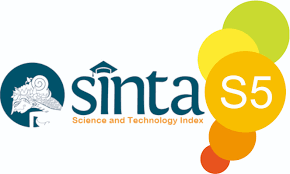Development of Traditional Culinary as a Tourism Attraction in Surakarta City
 Abstract views: 276
,
Abstract views: 276
,
 pdf downloads: 290
pdf downloads: 290
Abstract
The cultural wealth in Surakarta city that has great potential to be developed within the tourism framework is culinary. This article aims to identify the types of traditional food and formulate a program to create traditional food as culinary tourism. The data collection of this article uses direct observation in the field, interviews and documentation studies, while the data analysis uses a SWOT matrix. The results of this study reveal that in the city of Surakarta, there are several types of traditional food, such as Selat Solo, Tengkleng, Timlo Solo, Pecel Ndeso, Gudeg Ceker, Brambang Asem, Krengsengan, Serabi Notosuman, which can be developed as culinary tourism. Tourists' perception of traditional food processing is quite good on the quality of conventional food, food hygiene and service quality. Some programs conducted by the government to develop traditional food are improving the quality of human resources, creating markets for conventional food, identifying potential local products and assessing traditional food. The stall owners also developed programs such as menu adjustment, creativity in conventional food processing, and promotion.
Downloads
References
[2] Araujo, E. B. (2016). Pengembangan Kuliner Lokal Sebagai Daya Tarik Wisata di Dili, Timor Leste. JUMPA, 3(1), 15–27.
[3] Damanik, J, dan Weber F Helmut. (2006). Perencanaan Ekowisata; Dari Teori KeAplikasi. Yogyakarta: Pusat Pariwisata UGM dan ANDI.
[4] Hu, M. L. M. (2010). Developing a core competency model of innovative culinary development. International journal of hospitality management, 29(4), 582-590. https://doi.org/10.1016/j.ijhm.2009.10.024
[5] Kotler, P., & Amstrong, G. (2004). Prinsip-prinsip Marketing. Jakarta: Salemba Empat. (Edisi Ketujuh).
[6] Lianisyah, U. Y., Rudiansyah, R., & Sugiarti, T. (2022). Pengembangan Daya Tarik Wisatawan Asing Melalui Rancangan Peta Wisata Berbahasa Mandarin di Kabupaten Wonogiri. Cakra Wisata, 23(2), 17-26.
[7] Miner, J. B., Smith, N. R., & Bracker, J. S. (1989). Role of entrepreneurial task motivation in the growth of technologically innovative firms. Journal of applied psychology, 74(4), 554.
[8] Pitana, I Gede dan I Ketut Diarta. 2009. Pengantar Ilmu Pariwisata. Yogyakarta: Penerbit Andi.
[9] Rangkuti, F. 2013. Analisis SWOT Teknik Membedah Kasus Bisnis. Jakarta: PT. Gramedia Pustaka Utama.
[10] Rachmawati, Y. 2005. Definisi Kreativitas: Strategi Pengembangan Kreativitas. Jakarta: Depdikbud.
[11] Saeroji, A., & Wijaya, D. A. (2017). Pemetaan wisata kuliner khas Kota Surakarta. Jurnal Pariwisata Terapan, 1(1), 13-27.
[12] Suriani, N. M. (2009). Seni Kuliner Bali Sebagai Salah Satu Daya Tarik Wisata Studi Kasus Di Warung Babi Guling Ibu Oka Di Kelurahan Ubud, Gianyar, Bali. Program Studi Magister (S2) Kajian Pariwisata. Universitas Udayana.
[13] Scarpato, R. (2002). Gastronomy studies in search of hospitality. Journal of Hospitality and Tourism Management, 9(2), 1-12.
[14] Wijaya, S. (2019). Indonesian food culture mapping: a starter contribution to promote Indonesian culinary tourism. Journal of Ethnic Foods, 6(1), 1-10.
[15] Yuliari, G., Riyadi, B., & Perdana, P. (2020). DEVELOPMENT OF GASTRONOMIC TOURISM AS A TOURIST ATTRACTION DURING THE COVID-19 PANDEMIC IN THE EX-SURAKARTA RESIDENCY. PalArch's Journal of Archaeology of Egypt/Egyptology, 17(8), 768-778.
Copyright (c) 2023 Siti Yumna Annisa, Rahmat Darmawan, Abdul Kadir Ritonga

This work is licensed under a Creative Commons Attribution-ShareAlike 4.0 International License.
Authors who publish with this journal agree to the following terms:
- The author (s) keeps copyright on any article.
- The author grants the journal, right of first publication with the work simultaneously licensed under a Creative Commons Attribution License that allows others to share the work with an acknowledgement of the work’s authorship and initial publication in this journal.
- Authors can enter separate, additional contractual arrangements for the non-exclusive distribution of the journal’s published version of the work (e.g., post it to an institutional repository or publish it in a book), with an acknowledgement of its initial publication in this journal.
- Authors are permitted and encouraged to post their work online (e.g., in institutional repositories or on their website) prior to and during the submission process, as it can lead to productive exchanges, as well as earlier and greater citation of published work.
- We distributed the article, and any associated published material under the Creative Commons Attribution-Share alike 4.0 International License




